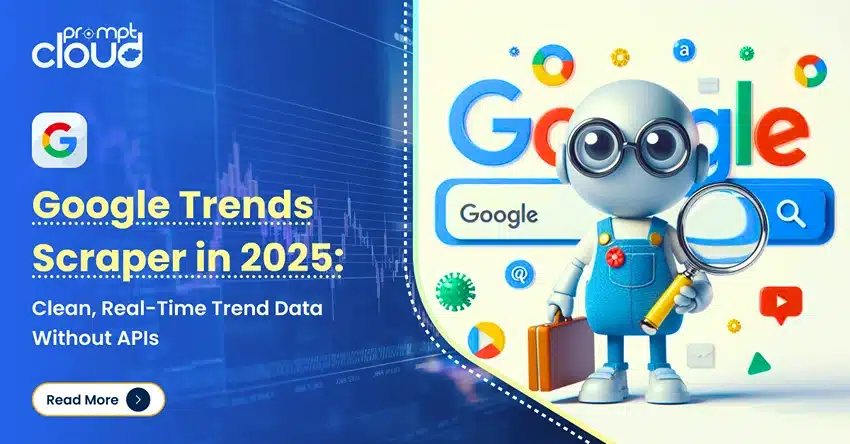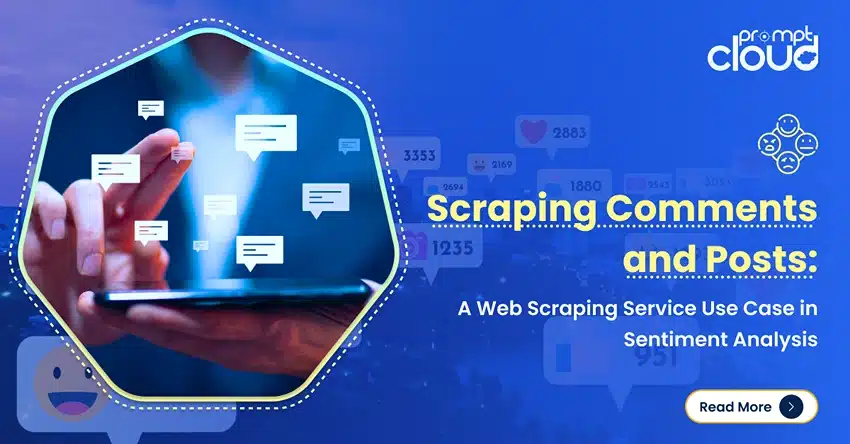
**TL;DR** Ever feel like you’re always a step behind what customers are saying about your brand online? That’s where a global consumer brand found itself with conversations happening on Instagram, Facebook, and niche forums faster than its team could track.
Partnering with PromptCloud changed that. Using our website data scraping services, they pulled millions of public comments and posts into one clean, structured feed. Their sentiment analysis models finally had the fuel they needed to catch early signs of frustration, spot emerging trends, and double down on what customers loved. The payoff? Happier customers, smarter campaigns, and a healthier brand reputation.
If you’re exploring social media scraping for sentiment analysis and want a proven playbook, this case study walks you through exactly how it works.
Why Sentiment Analysis Needs Quality Web Data
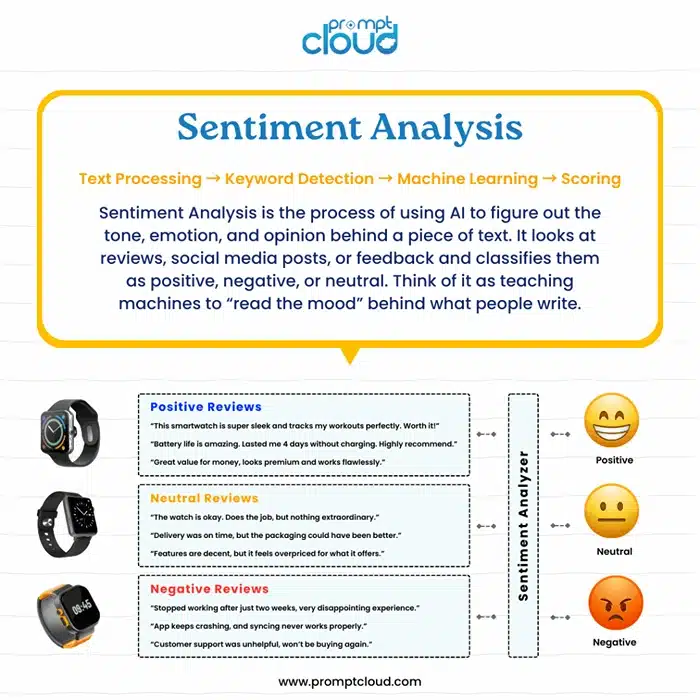
How can you tell what people think about your brand? Not the polite answers on a customer survey or the dozen reviews you happened to skim last week, but the unfiltered conversations happening right now on Instagram posts, Facebook threads, Reddit discussions, and even those niche forums only true fans (and critics) know about.
If you’re like most brands, you have more questions than answers. Are customers loving the latest product launch? Did that big ad campaign resonate, or just eat your budget? And what about those warning signs, the one-star reviews, the sarcastic tweets, are they just noise, or the start of a bigger reputation problem?
Here’s the reality: customer sentiment is hiding in plain sight online. The problem isn’t that the data isn’t there; it’s that there’s too much of it, scattered across too many platforms. And trying to monitor it manually? That’s like standing in the middle of a crowded stadium with a notepad, hoping to catch every cheer, boo, and side conversation.
This is where sentiment analysis powered by web data comes in. When done right, it turns the chaos of unstructured comments and posts into clear signals you can act on. But, and this is a big but, the quality of your analysis is only as good as the data you feed it. If your models are running on scraps of incomplete or outdated info, you’re not just guessing; you’re guessing wrong.
That’s why more data science teams, CMOs, and product leads are turning to website data scraping services. Done ethically and at scale, they deliver the raw material sentiment models need: clean, structured, real-time conversations directly from the sources your customers use.
In the following case study, you’ll see exactly how a leading consumer brand used social media scraping and public comment data to unlock insights that reshaped their strategy and how you can too.
The Business Challenge: Tracking Brand Sentiment at Scale
Let’s rewind to where this case study began. A global consumer brand came to us with a familiar but pressing problem: they had no clear picture of how customers truly felt about their products in real time.
On paper, they were doing fine. Sales were steady, ad campaigns were running, and their customer support inbox wasn’t overflowing. But the marketing and product teams knew they were flying blind. Here’s why:
Customers weren’t just leaving feedback on their website. They were talking on Instagram, Facebook, Reddit, and even niche forums their team didn’t have on the radar. Some of those conversations were glowing reviews. Others? Early signs of frustration about product quality and pricing could spread like wildfire if left unchecked.
The team tried the obvious fixes:
- A junior analyst is tasked with checking social channels once a week.
- A third-party social listening tool that skimmed surface-level mentions but missed context and nuance.
None of it worked. The data was incomplete, inconsistent, and way too slow. By the time an issue surfaced on their radar, it was often too late to respond effectively.
What they really needed wasn’t “a better intern with more browser tabs.” They needed a scalable way to scrape public data directly from where their customers were talking. Not vanity metrics like follower counts, but raw, unfiltered comments and posts they could feed into their sentiment analysis models.
In short, they needed social media scraping done right, compliant, automated, and at a scale that manual monitoring could never achieve.
Data Sources and Strategy: Where and What to Scrape
Once the brand realized they couldn’t rely on scattered, manual monitoring, the next question was obvious: where exactly should we collect data, and what kind of data matters for sentiment analysis?
Here’s the truth: not all mentions are created equal. A random “like” on Instagram doesn’t tell you much. But a 50-word comment about why someone loved (or hated) your product? That’s gold. The same goes for a niche discussion on Reddit or a Facebook post from a loyal customer sharing an unfiltered experience.
We worked with the brand to identify the platforms where their customers were most active:
- Instagram and Facebook: The big two for direct consumer conversations. We focused on ways to scrape Instagram comments and scrape Facebook comments, targeting relevant hashtags, brand-owned pages, and even competitor mentions.
- Industry forums and Reddit threads: These spots often have brutally honest feedback that doesn’t always make it to mainstream social media.
- Public product review sites: Because context matters, the same product can be praised on one channel and critiqued on another.
Here’s the key point: all this data was publicly available. Compliance and ethics weren’t afterthoughts; they were baked into the strategy. We built crawlers to scrape public data in a way that respected platform rules and user privacy.
The raw inputs included:
- Text of comments and posts (the actual opinions)
- Timestamps (because yesterday’s complaint carries more weight than one from a year ago)
- Public user metadata (like region or language, without touching personal or private info)
From there, the goal wasn’t to drown the brand in a mountain of raw text. It was to deliver structured, usable feeds of data clean enough for machine learning models and dashboards without hours of manual cleanup.
The result? Instead of opening a dozen tabs and scrolling endlessly, their data science team could focus on analysis, identifying trends, running sentiment models, and pulling insights that drive decisions.
it’s time to rethink your setup. PromptCloud can keep your crawlers steady, your data reliable, and your team focused on insights — not endless patchwork.
Talk to us and watch your strategy come alive.
How PromptCloud Solved It: Methodology and Scale
This was the point where plans turned into action. After pinpointing where their customers were talking and which data would move the needle, we built a scraping pipeline designed to deliver reliably, ethically, and at the scale they needed.
The process wasn’t about throwing bots at the internet and hoping for the best. It started with specific goals: which platforms, what kind of posts or comments, and how frequently the brand needed updates. From there, our team set up custom crawlers tuned for each source. Instagram and Facebook? Different structures, different rules. Forums and review sites? A whole other set of challenges.
The result:
- Millions of records collected per month, across multiple regions and languages.
- Automated cleaning and structuring, so the data was ready for sentiment models without weeks of prep work.
- Real-time delivery via APIs and dashboards, so the insights could actually be used while they still mattered.
One of the biggest challenges? Making sense of unstructured text. People don’t write in neat little spreadsheets; they use slang, drop emojis, and sometimes get sarcastic. To make that chaos usable, we baked normalization and tagging right into the pipeline. Every comment came with built-in context: language detection, where it came from, and when it was posted.
Why Not “Scrape the Entire Web”?
We get this question a lot: “Why not just scrape everything, or pull from Google search results and call it a day?” It sounds tempting, but here’s the catch: more data isn’t always better data.
Scraping Google or “the entire web” gives you noise, not insight. Search engines index snippets; they don’t hand you the full conversation or the context that sentiment analysis needs. Plus, platforms like Instagram or Facebook have specific structures and rules; you can’t rely on a generic search result to pull the right comment data at the right time.
Instead, the winning strategy is focus. For this brand, we zeroed in on specific sites and conversations relevant to their customers and products. That’s how you get clean, actionable data instead of an overwhelming firehose you can’t use.
The Scale That Makes a Difference
To give you a sense of impact: at peak, this pipeline was pulling hundreds of thousands of new comments per day across channels. Because it was automated, the brand’s analysts didn’t have to worry about missing a post or being a week behind on trending issues. The data fed straight into their sentiment models and dashboards are updated as frequently as every few hours.
This combination of focus, scale, and context is what turned a scattered data problem into a steady stream of insights. It’s also what separates a professional website data scraping service from ad-hoc scripts or one-off crawls.
Business Impact: Turning Scraped Data into Sentiment Insights
Pulling in millions of comments and posts is only step one. On its own, raw data is just noise. The real value shows up when you turn it into insights your team can act on. For this brand, that transformation unlocked some game-changing wins.
Once the structured feeds started flowing into their analytics stack, their data science team ran sentiment models that could finally pick up on patterns they were blind to before. Instead of just a star rating average, they could see why customers felt the way they did. Here’s what that looked like in practice:
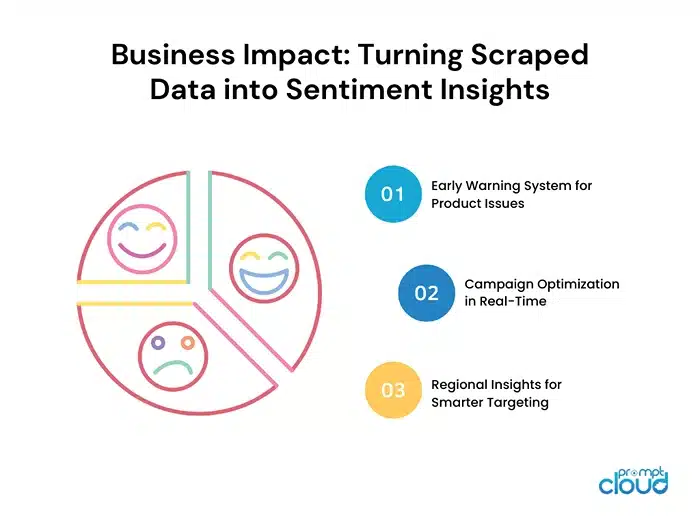
- Early Warning System for Product Issues:
Within weeks, they spotted a recurring complaint about a popular product’s packaging that wasn’t showing up in support tickets yet. Because they caught it early, the brand fixed the issue before it blew up publicly, saving both reputation and costly returns.
- Campaign Optimization in Real Time:
In the middle of a big social campaign, they spotted something interesting: one ad format was driving a surge of positive buzz, while another was falling flat. Rather than wait for the campaign report weeks later, they shifted budget on the fly and saw engagement jump by more than 20%.
- Regional Insights for Smarter Targeting:
The scraped data included language and region context (all from public fields), revealing that customers in one market loved a certain product feature while another market barely mentioned it. The marketing team used this to localize messaging and saw a measurable lift in conversions.
These aren’t just “feel-good” wins. They translated directly into hard numbers: a notable increase in positive sentiment scores, higher campaign ROI, and fewer costly product escalations. In fact, a Forrester study backs this up: companies that actively use sentiment data grow revenue 30% faster than those that don’t.
What’s important here is that the brand wasn’t guessing anymore. They weren’t reacting to problems after the fact. With PromptCloud’s website data scraping services delivering structured social media scraping feeds, they could make decisions while the conversations were still happening.
And that’s the real business impact: faster insights, smarter strategy, and a tighter connection to what customers feel, not just what you think they feel.
Why PromptCloud: What Sets Our Social Media Scraping Apart
By this point, you’ve seen how sentiment analysis depends on clean, relevant data. But here’s the kicker: not every web scraping vendor can deliver that at the level your business needs. This is where PromptCloud stands apart.
First, we don’t do one-size-fits-all feeds. Every brand has a unique footprint online, and your data pipeline should reflect that. With PromptCloud, you don’t get a generic “social mentions” report. You get a customized scraping setup tuned to your industry, your channels, and the context you care about, whether that’s scraping Instagram comments on branded hashtags, monitoring niche forums for early complaints, or keeping tabs on Facebook comments during a campaign.
Second, compliance and reliability aren’t afterthoughts. Decision-makers at this stage of the funnel often worry: “Will this vendor respect platform rules and user privacy?” With PromptCloud, the answer is yes. We scrape only public data, respect robots.txt guidelines, and deliver feeds designed to meet enterprise compliance needs. You get peace of mind knowing your sentiment insights aren’t coming from questionable sources.
Third, scale without chaos. Some vendors drown you in raw, messy text and call it a day. Our infrastructure is built to handle millions of records per month while cleaning and structuring the data on the way out. That means you’re not burning hours on preprocessing; you’re diving straight into analysis. And because our feeds integrate seamlessly via APIs or dashboards, your data flows directly into your analytics stack with zero friction.
Finally, partnership matters. Choosing a scraping provider isn’t like buying a software license; it’s choosing a long-term partner. Our team doesn’t just set up a crawler and vanish. We work with you to adjust sources, troubleshoot new site layouts, and even fine-tune what we scrape as your strategy evolves. Because when your data needs change they you will want a partner who adapts with you.
This combination of focus, compliance, and scalability is why leading brands trust PromptCloud’s website data scraping services for their social media scraping and sentiment projects. It’s not just about “getting the data.” It’s about getting the right data, in the right format, at the right time.
Key Takeaways for Decision-Makers
At this stage, you’re not here for theory; you want to know if investing in large-scale sentiment analysis via scraped comment and post data is worth it, and if so, what separates a good approach from a wasted budget. Here are the core lessons this case study highlights:
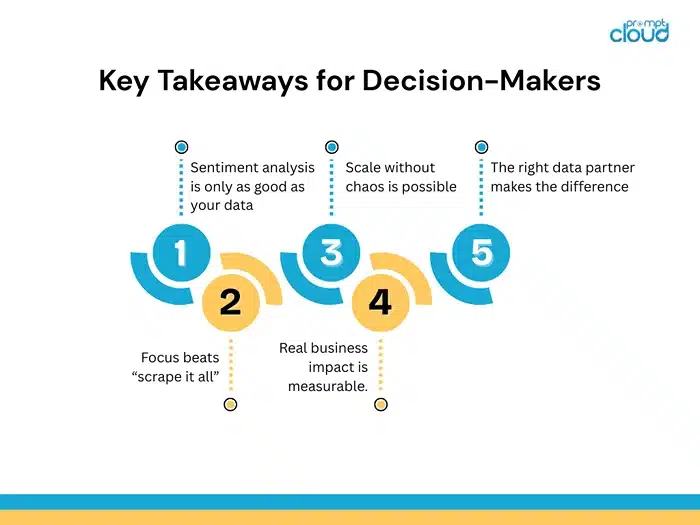
1. Sentiment analysis is only as good as your data.
No matter how sophisticated your models are, if you’re feeding them incomplete or outdated information, you’re making decisions on shaky ground. Scraping public data from platforms where your customers talk, Instagram, Facebook, and forums, gives you a clear, unbiased view of what’s really happening.
2. Focus beats “scrape it all.”
Trying to scrape the “entire web” or just pulling Google search results sounds appealing, but it floods you with noise and misses the conversations that matter. Targeted social media scraping of relevant sources yields clean, context-rich data that drives real insight.
3. Scale without chaos is possible.
Manually collecting data doesn’t cut it. The brand in our case study scaled to millions of records per month without drowning in unstructured text because they used a managed, enterprise-grade solution. Automation plus structure equals actionable intelligence.
4. Real business impact is measurable.
This isn’t about vanity metrics. Early issue detection, campaign optimization, and regional targeting, these insights turned directly into higher ROI and stronger brand health. That’s the power of pairing website data scraping services with sentiment analysis.
5. The right data partner makes the difference.
Scraping for sentiment isn’t a one-off tech task; it’s an ongoing part of your growth playbook. The real advantage comes from partnering with a team that gets compliance, can tailor the data to your goals, and evolves with you. That’s how a simple data feed turns into a real competitive edge.
If you’re leading data, marketing, or product, the message is simple: customer sentiment is shaping your market with or without your input. The brands pulling ahead are the ones tuning in at scale and making moves while it still counts.
Turning Customer Conversations into Strategy
Customer sentiment is out there in every Instagram comment, Facebook thread, and niche forum post. The challenge isn’t whether your customers are talking; it’s whether you’re listening in a way that drives action.
In this case study, the brand didn’t just collect random data; they tapped into structured, real-time conversations using PromptCloud’s website data scraping services. The result? Sentiment insights that shaped product fixes, guided marketing spend and strengthened their brand’s reputation.
If you’re evaluating vendors for social media scraping and sentiment projects, the question is simple: Do you want to keep guessing what your customers feel, or start knowing?
Schedule a demo with us today and learn how we can turn public conversations into your next competitive advantage.
it’s time to rethink your setup. PromptCloud can keep your crawlers steady, your data reliable, and your team focused on insights — not endless patchwork.
Talk to us and watch your strategy come alive.
FAQs:
Think of web scraping as the data pipeline your models have been missing. Instead of relying on a few screenshots or one-off reports, you pull public comments and posts from the places your customers talk Instagram, Facebook, forums, and review sites. With PromptCloud’s website data scraping services, that raw conversation gets cleaned, structured, and delivered in a format your team can plug straight into dashboards or machine learning. The result is simple: your sentiment analysis stops guessing and starts reflecting real customer language, in real time.
Yes, when you do it the right way. We scrape public data only, respect platform rules (including robots.txt), and avoid anything private or behind a login. That means no workarounds, no gray areas, and no surprises for your compliance team. If you’re evaluating vendors, ask them to spell out how they handle social media scraping ethically; the right answer should sound a lot like this.
Any category where customers talk online and that’s nearly all of them. Consumer brands and eCommerce use it to spot product issues early and tune campaigns while they’re live. Travel and fintech teams lean on it to understand trust signals, pain points, and region-specific trends. If your customers leave comments, reviews, or posts, sentiment from scraped public data becomes a practical edge for marketing, product, and CX.
Accuracy improves when the inputs improve. When your data comes clean and structured with details like timestamps, language, and where it came from your models can tell the difference between a throwaway joke and a real complaint. That’s why we don’t waste time trying to “scrape the whole web.” Instead, we zero in on the sources that matter most to your brand, whether that’s scraping Instagram comments or pulling Facebook threads, and deliver everything in a consistent format. The payoff? Fewer false positives, sharper trends, and insights your team can trust.
This isn’t a quick, one-off script; you set and forget it’s a living process. Websites change their layouts, traffic surges come out of nowhere, and compliance rules keep shifting. A managed partner like PromptCloud keeps the pipelines healthy, the data clean, and the delivery on schedule, so your team spends time on insights, not maintenance. If you’re evaluating vendors at, look for three things: focus on the sources that matter to you, transparent compliance practices, and the ability to scale without drowning you in cleanup work.






![Export Website To CSV A Practical Guide for Developers and Data Teams [2025 Edition]](https://www.promptcloud.com/wp-content/uploads/2025/10/Export-Website-To-CSV-A-Practical-Guide-for-Developers-and-Data-Teams-2025-Edition-100x80.webp)





![Export Website To CSV A Practical Guide for Developers and Data Teams [2025 Edition]](https://www.promptcloud.com/wp-content/uploads/2025/10/Export-Website-To-CSV-A-Practical-Guide-for-Developers-and-Data-Teams-2025-Edition.webp)

